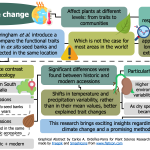Plant Science Research Weekly: January 15, 2021
Horizontal genome transfer by cell-to-cell travel of whole organelles
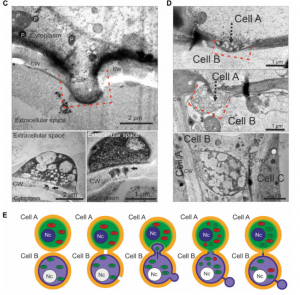 Textbooks tell us that eukaryotic cells acquired first mitochondria and later plastids through assimilation and retention of useful prokaryotes, but textbooks also imply that these were one-off occurrences that happened long ago. In the past several years, evidence has been accruing that genomes from organelles can move between cells in animal as well as plant tissues, particularly graft junctions. Here, Hertle et al. investigated how this happens, and specifically whether DNA alone moves or entire organelles move into cells of the graft partner. By applying cryo-SEM and other imaging methods to in the callus tissue that forms at the graft interface, bud-like protrusions of cytoplasm with organelle inclusions could be seen extruding through pores in cell walls. During the grafting process, plasmodesmata must reform between donor tissues, so these pores might represent a stage of that process. The small, dedifferentiated plastids present in the extruded cytoplasm are motile, described by the authors as “highly mobile amoeboid plastids” as demonstrated in the supplementary movies. As the authors conclude, “These findings unambiguously demonstrate that genomes move horizontally in graft unions via organelle travel from cell to cell.” (Summary by Mary Williams @PlantTeaching) Sci. Advances 10.1126/sciadv.abd8215
Textbooks tell us that eukaryotic cells acquired first mitochondria and later plastids through assimilation and retention of useful prokaryotes, but textbooks also imply that these were one-off occurrences that happened long ago. In the past several years, evidence has been accruing that genomes from organelles can move between cells in animal as well as plant tissues, particularly graft junctions. Here, Hertle et al. investigated how this happens, and specifically whether DNA alone moves or entire organelles move into cells of the graft partner. By applying cryo-SEM and other imaging methods to in the callus tissue that forms at the graft interface, bud-like protrusions of cytoplasm with organelle inclusions could be seen extruding through pores in cell walls. During the grafting process, plasmodesmata must reform between donor tissues, so these pores might represent a stage of that process. The small, dedifferentiated plastids present in the extruded cytoplasm are motile, described by the authors as “highly mobile amoeboid plastids” as demonstrated in the supplementary movies. As the authors conclude, “These findings unambiguously demonstrate that genomes move horizontally in graft unions via organelle travel from cell to cell.” (Summary by Mary Williams @PlantTeaching) Sci. Advances 10.1126/sciadv.abd8215
Evidence for phloem loading via the abaxial bundle sheath cells in maize leaves
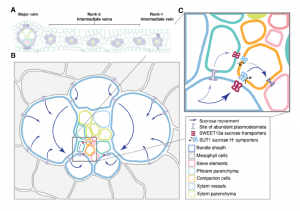 Every student knows that in a C4 plant like maize, photosynthetic carbohydrates are synthesized in the bundle sheath cells that surround the vein. These carbohydrates are then transported into the phloem for delivery to other tissues. Previous studies have identified SWEET (Sugars Will Eventually be Exported Transporterd) membrane proteins as mediating sucrose efflux from bundle sheath cells. Here, Bezrutczyk et al. used a single-cell sequencing strategy (followed up with in situ mRNA hybridization) to query the cell-type specific expression of these genes in maize. They found in that smaller veins, the main site of phloem loading in maize, three SWEET13 paralogues (previously shown to be necessary for phloem loading) are specifically expressed in the abaxial (lower) bundle sheath cells, as well as nearby phloem parenchyma cells. These findings suggest a distinct pattern of phloem loading in maize as compared to barley and Arabidopsis and may be a specific adaptation in maize and possibly other C4 plants. (Summary by Mary Williams @PlantTeaching) Plant Cell 10.1093/plcell/koaa055
Every student knows that in a C4 plant like maize, photosynthetic carbohydrates are synthesized in the bundle sheath cells that surround the vein. These carbohydrates are then transported into the phloem for delivery to other tissues. Previous studies have identified SWEET (Sugars Will Eventually be Exported Transporterd) membrane proteins as mediating sucrose efflux from bundle sheath cells. Here, Bezrutczyk et al. used a single-cell sequencing strategy (followed up with in situ mRNA hybridization) to query the cell-type specific expression of these genes in maize. They found in that smaller veins, the main site of phloem loading in maize, three SWEET13 paralogues (previously shown to be necessary for phloem loading) are specifically expressed in the abaxial (lower) bundle sheath cells, as well as nearby phloem parenchyma cells. These findings suggest a distinct pattern of phloem loading in maize as compared to barley and Arabidopsis and may be a specific adaptation in maize and possibly other C4 plants. (Summary by Mary Williams @PlantTeaching) Plant Cell 10.1093/plcell/koaa055
Single-cell RNA sequencing of developing maize ears facilitates functional analysis and trait candidate gene discovery
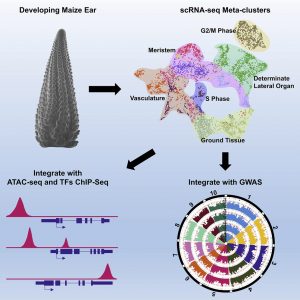 The maize ear has a complex morphology consisting of a series of meristems that are organized into cell types and domains. Xu et al. used single cell RNA sequencing (scRNA-seq) to identify spatial regulators of maize ear development. Over 12,500 individual cells and 28,900 genes were analyzed. 12 meta-clusters were predicted, with inflorescence markers from maize or Arabidopsis used to predict the cell or domain identities of these clusters. The results were validated by in situ hybridization and florescence-activated cell sorting RNA-seq data set. Three applications of the single cell atlas were demonstrated. First, the data predicted redundancy in a maize TPP gene family, which was subsequently validated by multiplex gene-editing using CRISP-Cas9. Second, gene expression is partly controlled by the binding of a transcription factor (TF) to its target genes, therefore targets of a TF should be co-expressed in the same cell types. Based on this underlying assumption, the authors integrated scRNA-seq with ChIP-seq data to build transcriptional regulatory networks. Finally, candidate genes associated with maize ear morphology traits were identified using the association between scRNA-seq marker genes and ear morphology trait SNPs identified in a GWAS panel. The scRNA-seq atlas generated will serve as a valuable resource for maize developmental genetics studies and breeding. (Summary by Toluwase Olukayode @toluxylic) Devel. Cell 10.1016/j.devcel.2020.12.015
The maize ear has a complex morphology consisting of a series of meristems that are organized into cell types and domains. Xu et al. used single cell RNA sequencing (scRNA-seq) to identify spatial regulators of maize ear development. Over 12,500 individual cells and 28,900 genes were analyzed. 12 meta-clusters were predicted, with inflorescence markers from maize or Arabidopsis used to predict the cell or domain identities of these clusters. The results were validated by in situ hybridization and florescence-activated cell sorting RNA-seq data set. Three applications of the single cell atlas were demonstrated. First, the data predicted redundancy in a maize TPP gene family, which was subsequently validated by multiplex gene-editing using CRISP-Cas9. Second, gene expression is partly controlled by the binding of a transcription factor (TF) to its target genes, therefore targets of a TF should be co-expressed in the same cell types. Based on this underlying assumption, the authors integrated scRNA-seq with ChIP-seq data to build transcriptional regulatory networks. Finally, candidate genes associated with maize ear morphology traits were identified using the association between scRNA-seq marker genes and ear morphology trait SNPs identified in a GWAS panel. The scRNA-seq atlas generated will serve as a valuable resource for maize developmental genetics studies and breeding. (Summary by Toluwase Olukayode @toluxylic) Devel. Cell 10.1016/j.devcel.2020.12.015
The PB1 domain-containing protein PB1CP negatively regulates the NADPH oxidase RBOHD in plant immunity
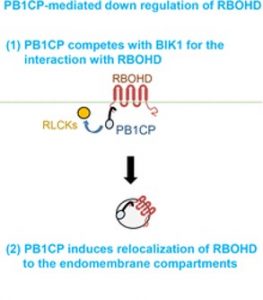 Plants produces ROS (Reactive Oxygen Species) as an immune response against infection. ROS induces additional immune response, but high ROS levels have detrimental effects on plant cellular function. To understand how plants produce just the right amount of ROS, Goto et al. the studied regulation of RBOHD, the NADPH oxidase involved in production of ROS during plant immunity. Using mass spectrometry, the authors identified PB1CP, a PB1 (phagocytosis oxidase/Bem1p)-domain containing protein, as one of the interacting proteins. Through ROS production analysis of PB1CP mutant and overexpression lines, the authors showed that PB1CP negatively regulates PAMP (Pathogen Associated Molecular Pattern)-induced ROS production. The authors also showed re-localization of PB1CP after PAMP treatment from the cell periphery to endomembrane compartments, which reduces the cell membrane expression of RBOHD. (Summary by Sunita Pathak @psunita980) bioRxiv 10.1101/2020.12.28.423414
Plants produces ROS (Reactive Oxygen Species) as an immune response against infection. ROS induces additional immune response, but high ROS levels have detrimental effects on plant cellular function. To understand how plants produce just the right amount of ROS, Goto et al. the studied regulation of RBOHD, the NADPH oxidase involved in production of ROS during plant immunity. Using mass spectrometry, the authors identified PB1CP, a PB1 (phagocytosis oxidase/Bem1p)-domain containing protein, as one of the interacting proteins. Through ROS production analysis of PB1CP mutant and overexpression lines, the authors showed that PB1CP negatively regulates PAMP (Pathogen Associated Molecular Pattern)-induced ROS production. The authors also showed re-localization of PB1CP after PAMP treatment from the cell periphery to endomembrane compartments, which reduces the cell membrane expression of RBOHD. (Summary by Sunita Pathak @psunita980) bioRxiv 10.1101/2020.12.28.423414
Regulation of shoot meristem shape by photoperiodic signaling and phytohormones during floral induction of Arabidopsis
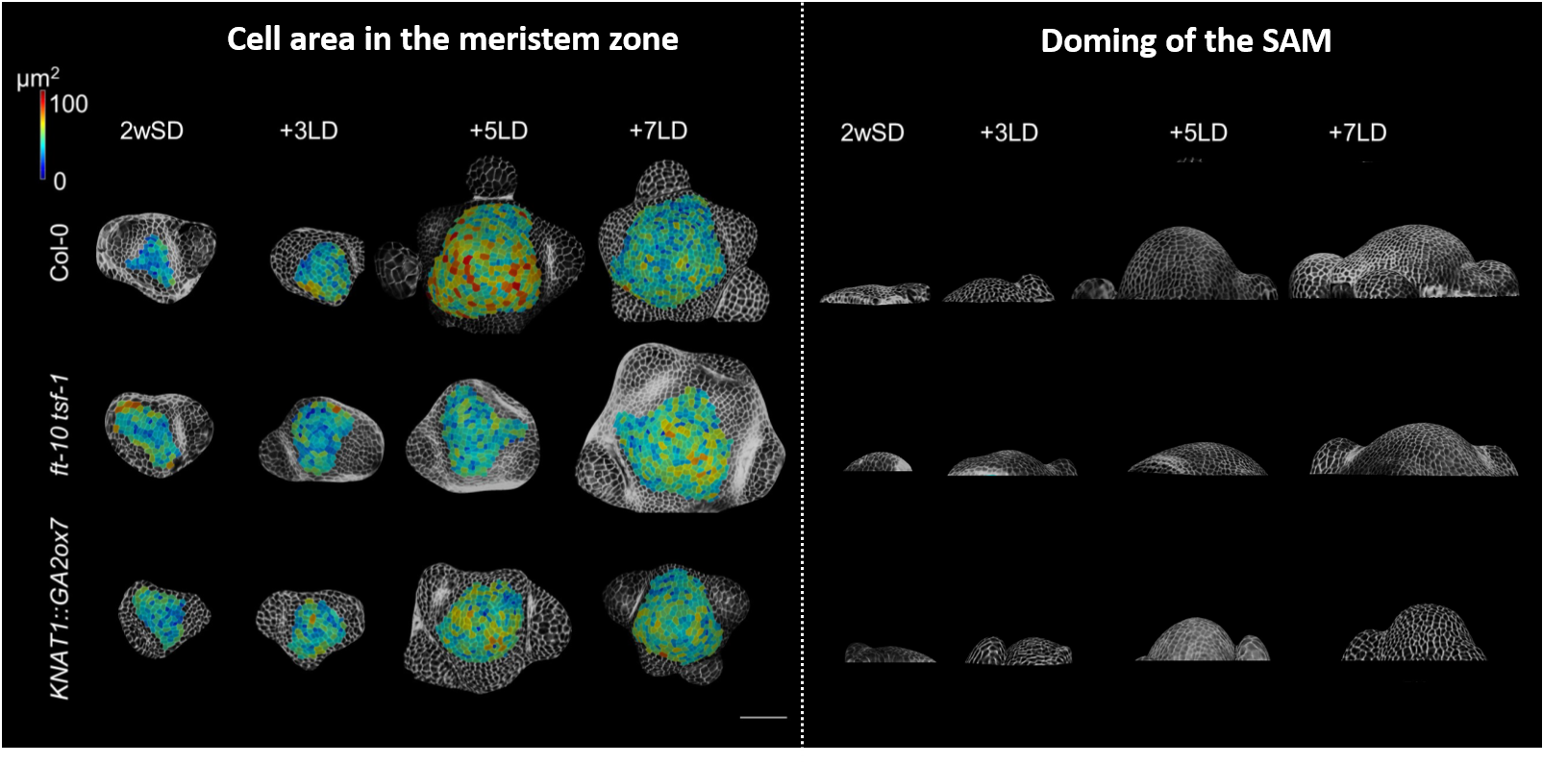
Angiosperms synchronize the floral transition with optimal internal and external conditions such as daylength to maximize reproductive success. Despite the wealth of knowledge on the molecular mechanisms controlling flowering time, little is known about the cellular events that occur as the vegetative meristem converts into a reproductive meristem. Here, Kinoshita and coworkers combined confocal microscopy and live imaging techniques to define the morphological changes in the shoot apical meristem (SAM), which acquires a domed shape after transferring plants from short to long days. In wild-types plants, the SAM area enlarged rapidly upon induction due to increased number and size of meristematic cells. By contrast, plants carrying mutations in floral activators (ft tsf1) and in a gibberellic acid (GA) biosynthetic enzyme (ga20ox2-1) displayed a smaller SAM area and delayed doming, consistent with their late flowering phenotype. These findings indicated that both photoperiod and GA pathways contribute to alterations in SAM shape at the floral transition under LD. Two MADS transcription factors – previously described as components of the photoperiodic pathway – regulated the dynamic expression of a gene involved in GA catabolism by directly binding regulatory sequences in its promoter. Specifically, SOC1 negatively regulated GA2ox4 transcription in the SAM at the floral transition. Thus, seasonal cues and transient GA accumulation trigger cellular changes at the shoot apex underpinning the induction of flower development. (Summary and image adaptation by Michela Osnato @michela_osnato) eLife 10.7554/eLife.60661
Integration of cell growth and asymmetric division during lateral root initiation in Arabidopsis thaliana
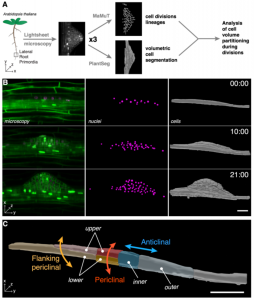 Lateral roots continually form and develop out of the primary root throughout the plant’s lifetime, enabling the root system to optimize its development to its environment. In this study, Schütz et al. used light-sheet microscopy to generate 4D movies of Arabidopsis lateral root primordia expressing markers to label the plasma membranes and nuclei. The images were analyzed to track nuclei and cell divisions (using the MaMuT pipeline) as well as cell shapes and volumes (using the PlantSeg pipeline), giving the authors a detailed look at the earliest stages of lateral root development. As described previously, the process begins with anticlinal divisions (perpendicular to the axis of the root) followed by periclinal divisions (parallel to the root axis and the circumferential plane). This detailed analysis revealed consistent asymmetry within the divisions and intense cell growth preceding periclinal divisions. The results indicate that “cells integrate growth and division to precisely partition their volume upon division during the first two stages of lateral root formation”. (Summary by Benjamin Jin) bioRxiv 10.1101/2020.12.15.422941
Lateral roots continually form and develop out of the primary root throughout the plant’s lifetime, enabling the root system to optimize its development to its environment. In this study, Schütz et al. used light-sheet microscopy to generate 4D movies of Arabidopsis lateral root primordia expressing markers to label the plasma membranes and nuclei. The images were analyzed to track nuclei and cell divisions (using the MaMuT pipeline) as well as cell shapes and volumes (using the PlantSeg pipeline), giving the authors a detailed look at the earliest stages of lateral root development. As described previously, the process begins with anticlinal divisions (perpendicular to the axis of the root) followed by periclinal divisions (parallel to the root axis and the circumferential plane). This detailed analysis revealed consistent asymmetry within the divisions and intense cell growth preceding periclinal divisions. The results indicate that “cells integrate growth and division to precisely partition their volume upon division during the first two stages of lateral root formation”. (Summary by Benjamin Jin) bioRxiv 10.1101/2020.12.15.422941
Plant roots sense soil compaction through restricted ethylene diffusion
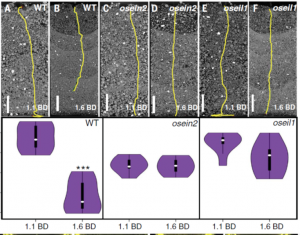 Soil is the growth substrate for most plants and contributes to their success through factors such as microbial ecology, chemistry and presence of nutrients, and physical properties including how compact it is. With increasing soil compaction (bulk density), roots are less able to penetrate, resulting in shorter, wider roots; these shorter roots are often less able to reach water and nutrients. Pandey et al. investigated why roots are shorter – is it simply that they cannot exert sufficient penetration force, or are other factors involved? The authors used computed tomography to watch roots grow in wild-type and ethylene insensitive rice. Strikingly, in wild-type plants, exogenous ethylene was sufficient to reproduce the effect of compacted soil, and conversely the ethylene insensitive mutants did not show the stunted phenotype in compacted soil, indicating that root growth is arrested by ethylene rather than mechanical impedance. They next queried the source of this ethylene, to determine if roots upregulate ethylene production when they sense soil compaction. Instead, they found that the increased ethylene response occurs because ethylene cannot diffuse effectively in denser soils, leading to a local increase in concentration. Intriguingly, the authors observe that this mechanism might allow growing roots to sense and avoid regions of high soil compaction. (Summary by Mary Williams @PlantTeaching) Science 10.1126/science.abf3013
Soil is the growth substrate for most plants and contributes to their success through factors such as microbial ecology, chemistry and presence of nutrients, and physical properties including how compact it is. With increasing soil compaction (bulk density), roots are less able to penetrate, resulting in shorter, wider roots; these shorter roots are often less able to reach water and nutrients. Pandey et al. investigated why roots are shorter – is it simply that they cannot exert sufficient penetration force, or are other factors involved? The authors used computed tomography to watch roots grow in wild-type and ethylene insensitive rice. Strikingly, in wild-type plants, exogenous ethylene was sufficient to reproduce the effect of compacted soil, and conversely the ethylene insensitive mutants did not show the stunted phenotype in compacted soil, indicating that root growth is arrested by ethylene rather than mechanical impedance. They next queried the source of this ethylene, to determine if roots upregulate ethylene production when they sense soil compaction. Instead, they found that the increased ethylene response occurs because ethylene cannot diffuse effectively in denser soils, leading to a local increase in concentration. Intriguingly, the authors observe that this mechanism might allow growing roots to sense and avoid regions of high soil compaction. (Summary by Mary Williams @PlantTeaching) Science 10.1126/science.abf3013
Seed functional traits provide support for ecological restoration and ex situ conservation in the threatened Amazon ironstone outcrop flora
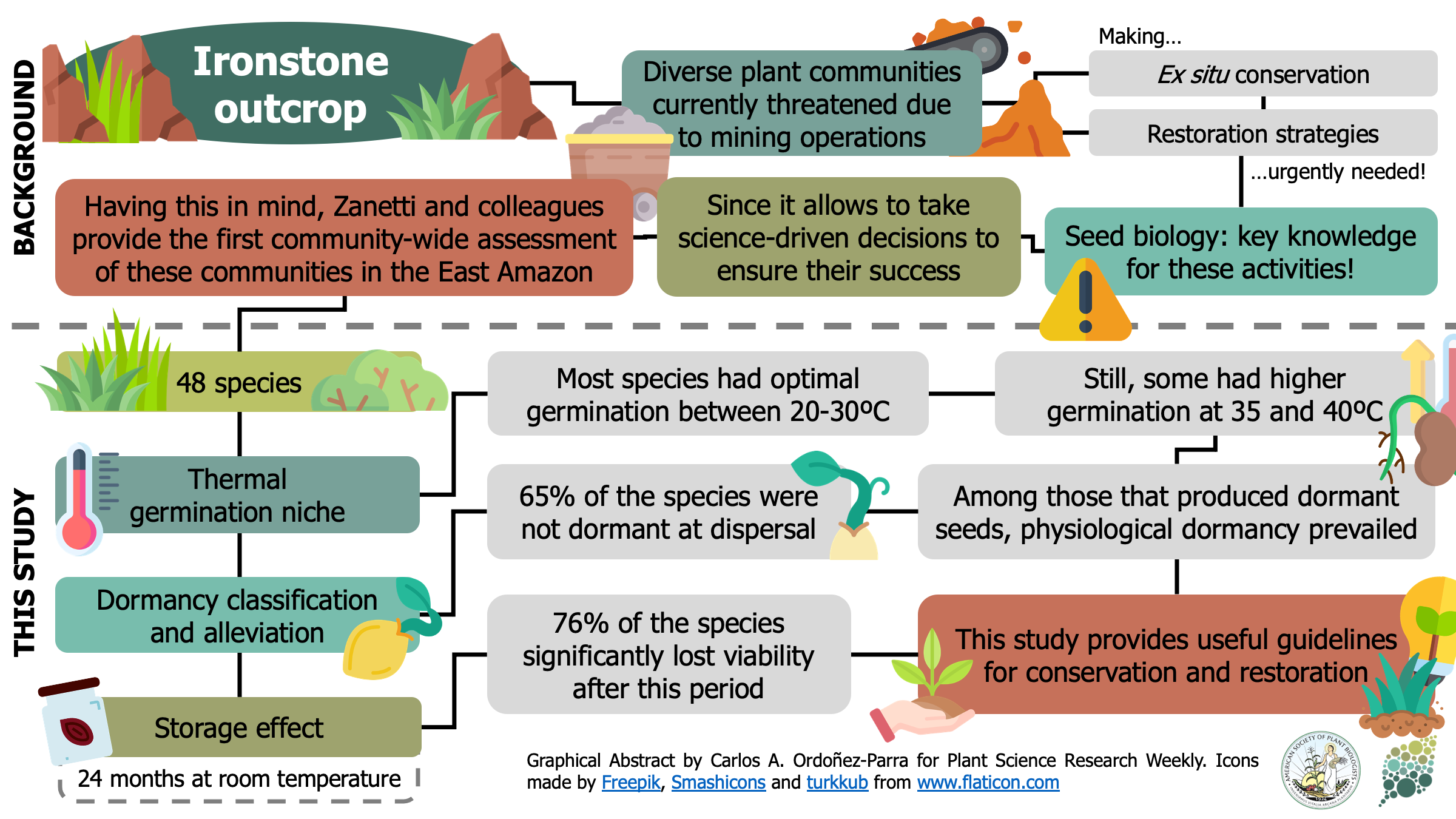
East Amazonian ironstone outcrops host highly diverse plant communities with impressive endemism levels (meaning the plants are found nowhere else), yet they are threatened by large-scale mining operations. As a result, proper conservation and restoration techniques are urgently needed to ensure their future. Zanetti and colleagues provide the first community-wide assessment of seed functional traits within these communities. Forty-eight species were analyzed to establish their thermal germination niche, assess the presence of dormancy, and test the effect of 24 months of storage. Most species produced non-dormant seeds and had their maximum germination between 20-30°C. After 24 months of storage under room temperature, 76% of the species experienced a significant reduction in viability; some of them had no viable seed after this period. This research provides promising guidelines for future conservation and restoration practices in ironstone outcrop communities and is an exciting starting point for seed ecology research in this ecosystem. (Summary by Carlos A. Ordóñez-Parra @caordonezparra) Front. Plant Sci. 10.3389/fpls.2020.599496
Time travelling seeds reveal that plant regeneration and growth traits are responding to climate change
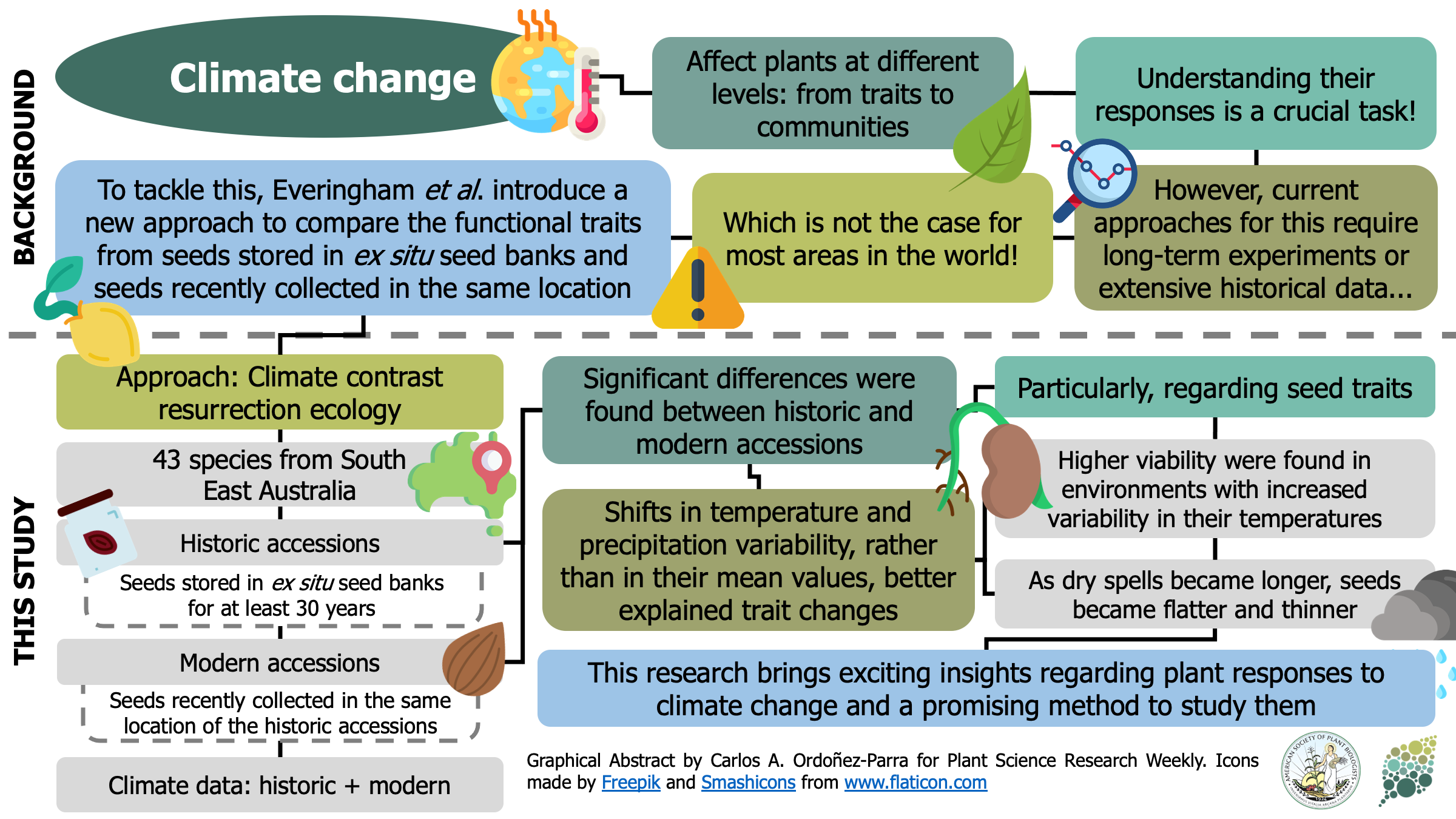
Increasing our understanding of how plants will respond to climate change is one of our most urgent challenges. However, most approaches require extensive historical records that are not available for most areas. In this paper, Everingham and colleagues compare the regeneration and growth traits of plants from seeds that have been stored in ex situ seed banks for several decades with those from seeds recently collected in the same location. Historical and modern accessions of 43 species from South Eastern Australia from different growth forms were used. Significant differences were found between current and historic plants in at least one trait, especially in those related to seeds. Interestingly, changes in mean temperature and mean precipitation were poor predictors of trait changes. Instead, shifts in the variability and range of temperature and precipitation regimes had higher predictive power. For instance, seed viability and germination percentage increased with temperature variability, and seeds became flatter and thinner as dry spells became longer. As a result, this fascinating research provides meaningful insights regarding the plant responses to climate change and a promising method to facilitate the study of plant responses in other parts of the world. (Summary by Carlos A. Ordóñez-Parra @caordonezparra) Ecology 10.1002/ecy.3272



